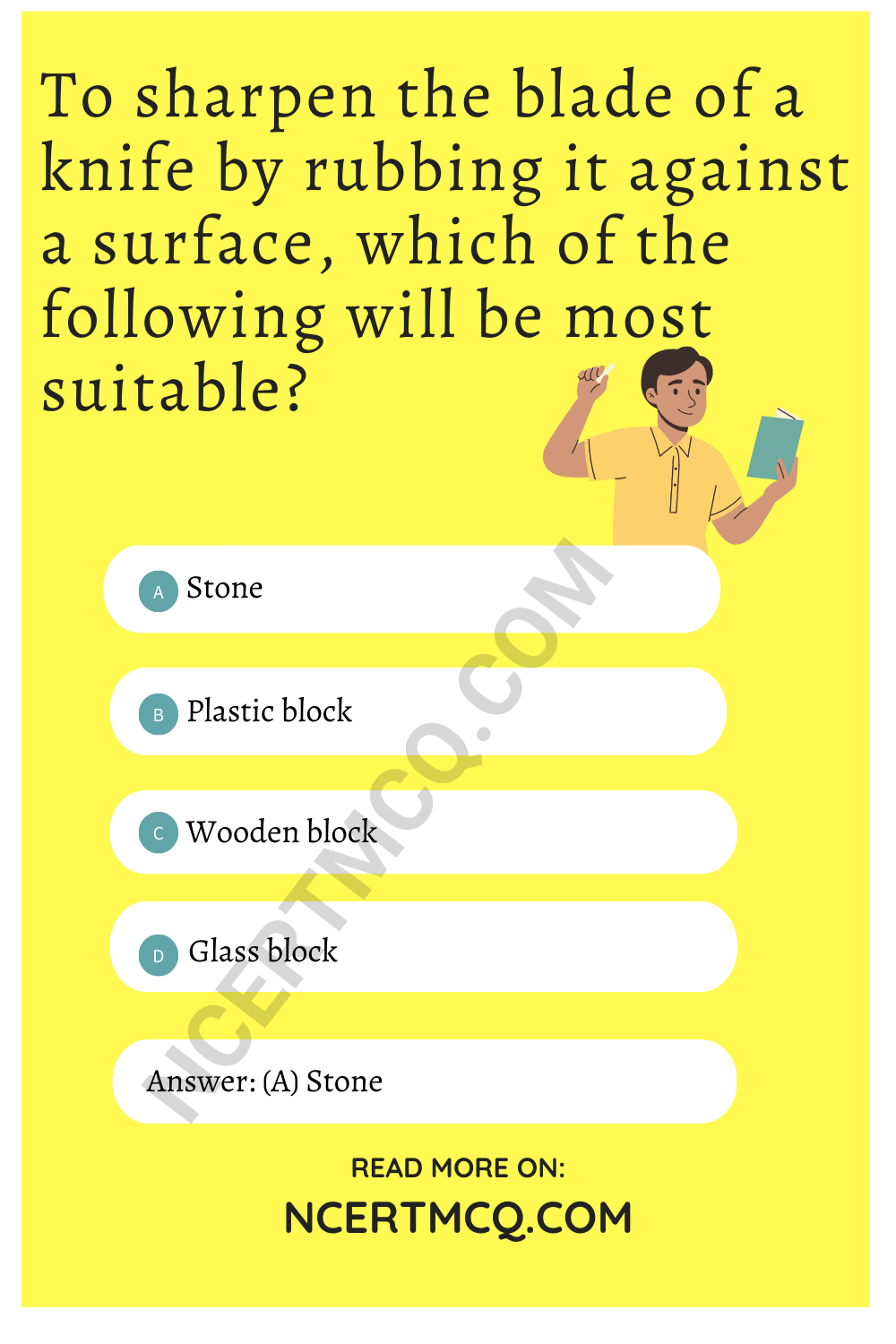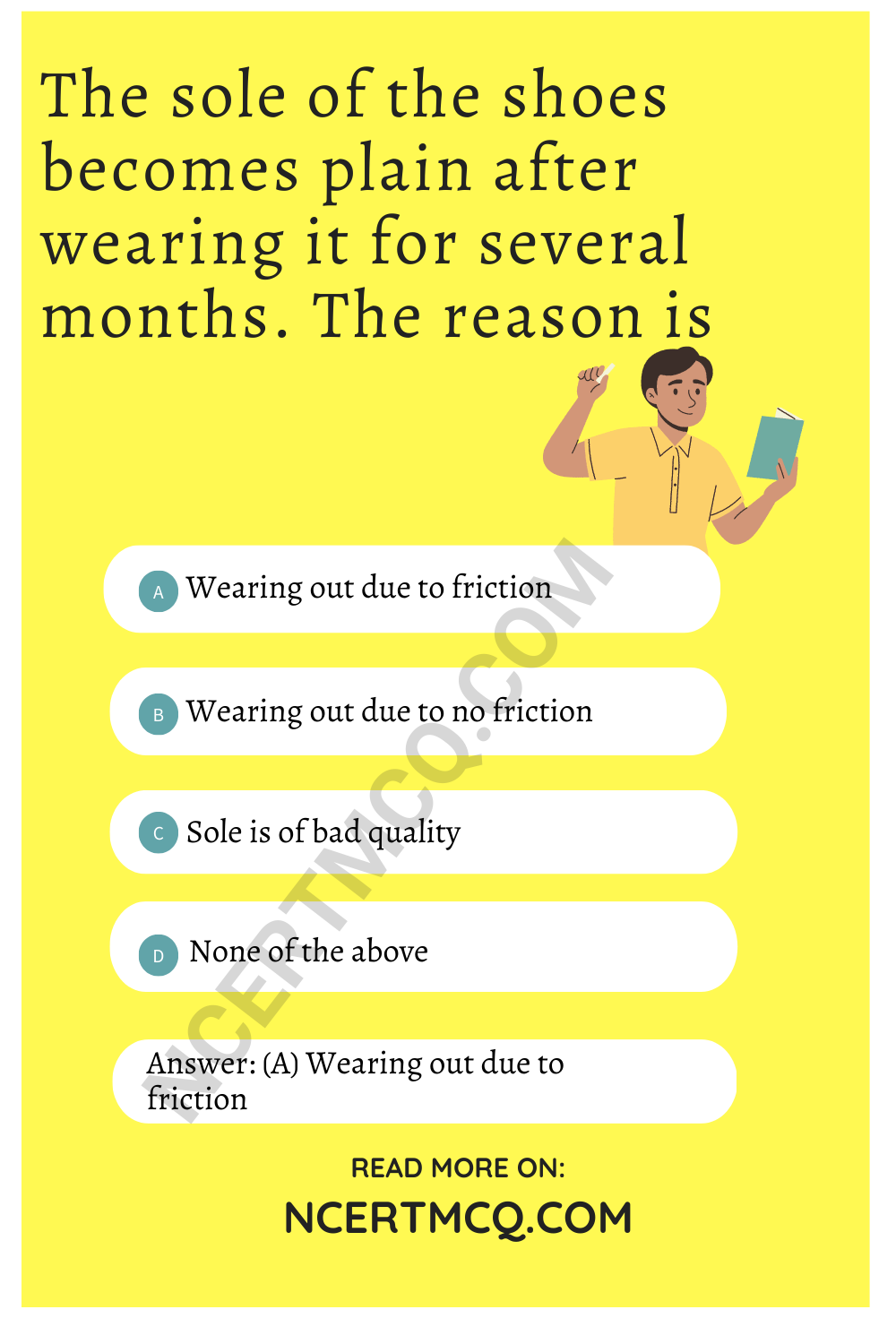Check the below Online Education NCERT MCQ Questions for Class 8 Science Chapter 12 Friction with Answers Pdf free download. MCQ Questions for Class 8 Science with Answers were prepared based on the latest exam pattern. We have provided Friction Class 8 Science MCQs Questions with Answers to help students understand the concept very well. https://ncertmcq.com/mcq-questions-for-class-8-science-with-answers/
You can refer to NCERT Solutions for Class 8 Science Chapter 12 Friction to revise the concepts in the syllabus effectively and improve your chances of securing high marks in your board exams.
Class 8 Science Chapter 12 MCQ With Answers
Science Class 8 Chapter 12 MCQs On Friction
Choose the correct option.
Friction Class 8 MCQ Question 1.
Friction is a
(a) non-contact force
(b) contact force
(c) magnetic force
(d) electrostatic force
Answer
Answer: (b) contact force
Class 8 Science Chapter 12 MCQ Question 2.
Which of the following produces least friction?
(a) Sliding friction
(b) Rolling friction
(c) Composite friction
(d) Static friction
Answer
Answer: (b) Rolling friction
Friction MCQ Class 8 Question 3.
Friction always
(a) opposes the motion
(b) helps the motion
(c) both (a) and (b)
(d) none of these
Answer
Answer: (a) opposes the motion
Class 8 Friction MCQ Question 4.
Friction can be reduced by using
(a) oil
(b) grease
(c) powder
(d) all of these
Answer
Answer: (d) all of these
MCQ On Friction Class 8 Question 5.
Static friction is less than
(a) sliding friction
(b) rolling friction
(c) both (a) and (b)
(d) none of these
Answer
Answer: (d) none of these
MCQ Of Friction Class 8 Question 6.
Whenever the surfaces in contact tend to move or move with respect to each other, the force of friction comes into play
(a) only if the objects are solid.
(b) only if one of the two objects is liquid.
(c) only if one of the two objects is gaseous.
(d) irrespective of whether the objects are solid, liquid or gaseous.
Answer
Answer: (d) irrespective of whether the objects are solid, liquid or gaseous.
MCQ Questions For Class 8 Science Chapter 12 Question 7.
To sharpen the blade of a knife by rubbing it against a surface, which of the following will be most suitable?
(a) Stone
(b) Plastic block
(c) Wooden block
(d) Glass block
Answer
Answer: (a) Stone

Class 8 Science Ch 12 MCQ Question 8.
The shape of an aeroplane is like a
(a) dog
(b) bird
(c) car
(d) all of these
Answer
Answer: (b) bird
Class 8 Science Friction MCQ Question 9.
Friction is
(a) foe
(b) friend
(c) both (a) and (b)
(d) none of these
Answer
Answer: (c) both (a) and (b)
Force And Friction Class 8 MCQ Question 10.
Friction due to fluids is called
(a) force
(b) pressure
(c) friction
(d) drag
Answer
Answer: (d) drag
MCQ Friction Class 8 Question 11.
Which of the following is not a smooth surface?
(a) Surface of wet soap
(b) Surface of tyres
(c) Glazed tiles
(d) Surface of mirror
Answer
Answer: (b) Surface of tyres
Ch 12 Science Class 8 MCQ Question 12.
A toy car released with the same initial speed will travel farthest on
(a) muddy surface
(b) polished marble surface
(c) cemented surface
(d) brick surface
Answer
Answer: (b) polished marble surface
Class 8 Science Chapter Friction MCQ Question 13.
If we apply oil on door hinges, the friction will
(a) increase
(b) decrease
(c) disappear altogether
(d) will remain unchanged
Answer
Answer: (b) decrease
Class 8 Chapter 12 Science MCQ Question 14.
Lubricant
(a) reduce friction
(b) increase friction
(c) both (a) and (b)
(d) none of these
Answer
Answer: (a) reduce friction
MCQs On Friction Class 8 Question 15.
Force of friction depends on
(a) roughness of surface
(b) smoothness of surface
(c) inclination of surface
(d) all of these
Answer
Answer: (d) all of these
Class 8 Ch 12 Science MCQ Question 16.
Force of friction depends on
(a) roughness of surface
(b) weight
(c) size
(d) all of these
Answer
Answer: (d) all of these
Chapter 12 Science Class 8 MCQ Question 17.
Fluids are
(a) liquids
(b) gases
(c) both (a) and (b)
(d) none of these
Answer
Answer: (c) both (a) and (b)
Question 18.
Which is a streamlined object?
(a) Boats
(b) Aeroplanes
(c) Ships
(d) All of these
Answer
Answer: (d) All of these
Question 19.
Smooth surface has
(a) less friction
(b) more friction
(c) sometimes less and sometimes more
(d) all of these
Answer
Answer: (a) less friction
Question 20.
Which of the following is responsible for wearing out of bicycle tyres?
(a) Muscular force
(b) Magnetic force
(c) Frictional force
(d) Electrostatic force
Answer
Answer: (c) Frictional force
Question 21.
It is difficult to walk on an oily floor because
(a) Floor gets spoiled
(b) There is more resistance
(c) Force of friction is high
(d) Force of friction is very less
Answer
Answer: (d) Force of friction is very less
Question 22.
Spring balance is a device used for measuring the _____________ acting on an object.
(a) mass
(b) pressure
(c) force
(d) None of the above
Answer
Answer: (c) force
Question 23.
A matchstick struck on a matchbox catches fire easily because
(a) Friction may cause fire
(b) Of chemical reaction
(c) Force heated the match stick
(d) None of the above
Answer
Answer: (a) Friction may cause fire
Question 24.
Tyres are treaded to
(a) look good
(b) Increase friction
(c) increase its longivity
(d) increase weight of the tyre
Answer
Answer: (b) Increase friction
Question 25.
Lubricants are substances which
(a) Increase friction
(b) Are used to light fire
(c) Reduce friction
(d) Are used to put out a fire
Answer
Answer: (c) Reduce friction
Question 26.
Sliding friction is _________ than / to rolling friction
(a) smaller
(b) greater
(c) equal
(d) None of the above
Answer
Answer: (b) greater
Question 27.
The frictional force exerted by fluids is also called ______
(a) drug
(b) drag
(c) drop
(d) drown
Answer
Answer: (b) drag
Question 28.
Four children were asked to arrange forces due to rolling, static and sliding frictions in an increasing order. Their arrangements are given below. Choose the correct arrangement.
(a) Rolling, Static, Sliding
(b) Static, Rolling, Sliding
(c) Rolling, sliding, static
(d) Sliding, Static, Rolling
Answer
Answer: (c) Rolling, sliding, static
Question 29.
A boat or an aeroplane has a pointed or tapering front / head. Why?
(a) To increase the friction of fluid
(b) To reduce the friction of fluid
(c) To look good
(d) For no reason
Answer
Answer: (b) To reduce the friction of fluid
Question 30.
The sole of the shoes becomes plain after wearing it for several months. The reason is
(a) Wearing out due to friction
(b) Wearing out due to no friction
(c) Sole is of bad quality
(d) None of the above
Answer
Answer: (a) Wearing out due to friction

Match the items given in column I suitably with those given in column II.
| Column I | Column II |
| 1. Fluid friction | (a) Due to friction |
| 2. Lubricants | (b) Streamlined |
| 3. Wheels | (c) Increases friction |
| 4. Spring balance | (d) Drag |
| 5. Shape of aeroplane | (e) Rolling friction |
| 6. Rough surface | (f) Reduce friction |
| 7. Heat generation | (g) Measures force |
Answer
Answer:
| Column I | Column II |
| 1. Fluid friction | (d) Drag |
| 2. Lubricants | (f) Reduce friction |
| 3. Wheels | (e) Rolling friction |
| 4. Spring balance | (g) Measures force |
| 5. Shape of aeroplane | (b) Streamlined |
| 6. Rough surface | (c) Increases friction |
| 7. Heat generation | (a) Due to friction |
Fill in the blanks with suitable word/s.
1. Sliding friction is ___________ than static friction.
Answer
Answer: less
2. Friction can be reduced by using ___________.
Answer
Answer: oil or powder or grease
3. Friction can be increased by making surface ___________.
Answer
Answer: rough
4. Rolling friction is ___________ than sliding and static friction.
Answer
Answer: less
5. Friction due to fluid is also called ___________.
Answer
Answer: drag
6. Bodies of birds, fishes and ships are ___________.
Answer
Answer: streamlined
7. Friction can also produce ___________.
Answer
Answer: heat
8. All objects moving in fluids have ___________ shape to reduce ___________.
Answer
Answer: streamlined, friction
9. Rough surfaces produce ___________ friction than smooth surfaces.
Answer
Answer: more
10. In many machines, friction is reduced by using ___________.
Answer
Answer: ball bearing
11. Friction depends on the ___________ of substances in contact.
Answer
Answer: nature
12. Static friction comes into play when we try to move an object at ___________.
Answer
Answer: rest
13. ___________ force is responsible for downward movement of a parachutist when he jumps from an aircraft
Answer
Answer: Gravitational
14. The sole of shoes and the tyres of vehicles are treaded to _________ friction.
Answer
Answer: increase
15. Friction is sometimes _________ .
Answer
Answer: undesirable
State whether the given statements are true or false.
1. Friction is always useful to us.
Answer
Answer: False
2. Fluids are only liquids.
Answer
Answer: False
3. Friction is less for smooth surfaces.
Answer
Answer: True
4. A soapy floor is slippery due to increased friction.
Answer
Answer: False
5. Friction always works in opposite direction to the relative motion.
Answer
Answer: True
6. Friction is dependent on area of contact.
Answer
Answer: False
7. Sliding friction is less than rolling friction.
Answer
Answer: False
8. Friction decreases with increase in the smoothness of the surface.
Answer
Answer: True
9. It is easier to move a heavy object than a light object.
Answer
Answer: False
10. Friction can be reduced by using lubricants.
Answer
Answer: True
11. Friction is independent of the nature of surfaces in contact.
Answer
Answer: False
12. A spring balance measures force.
Answer
Answer: True
13. Friction can be reduced by using ball bearings in some machines.
Answer
Answer: True
14. Friction can never be eliminated.
Answer
Answer: True
15. Friction do not produce heat.
Answer
Answer: False
We hope the given NCERT MCQ Questions for Class 8 Science Chapter 12 Friction with Answers Pdf free download will help you. If you have any queries regarding Friction CBSE Class 8 Science MCQs Multiple Choice Questions with Answers, drop a comment below and we will get back to you soon.
Class 8 Science MCQ:
- Crop Production and Management Class 8 MCQ
- Microorganisms: Friend and Foe Class 8 MCQ
- Synthetic Fibres and Plastics Class 8 MCQ
- Materials: Metals and Non-Metals Class 8 MCQ
- Coal and Petroleum Class 8 MCQ
- Combustion and Flame Class 8 MCQ
- Conservation of Plants and Animals Class 8 MCQ
- Cell Structure and Functions Class 8 MCQ
- Reproduction in Animals Class 8 MCQ
- Reaching the Age of Adolescence Class 8 MCQ
- Force and Pressure Class 8 MCQ
- Friction Class 8 MCQ
- Sound Class 8 MCQ
- Chemical Effects of Electric Current Class 8 MCQ
- Some Natural Phenomena Class 8 MCQ
- Light Class 8 MCQ
- Stars and the Solar System Class 8 MCQ
- Pollution of Air and Water Class 8 MCQ
